I’m excited to share a new “Spotlight Series” post with you today, featuring Katrina’s Art Studio. Katrina Richardson is an artist who paints beautiful designs on secondhand shoes that become upcycled shoe art. Not only are her creations fun and one-of-a-kind, but they give new life to used shoes that may otherwise end up in a landfill.
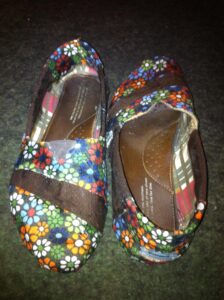 Several years ago, I attempted a shoe upcycle project of my own. Holes were wearing in the burlap fabric of my favorite Toms shoes before I was ready to toss them out. I found an upcycle idea on Pinterest that involved gluing fabric on the shoes to reinforce them and extend their life.
Several years ago, I attempted a shoe upcycle project of my own. Holes were wearing in the burlap fabric of my favorite Toms shoes before I was ready to toss them out. I found an upcycle idea on Pinterest that involved gluing fabric on the shoes to reinforce them and extend their life.
While they turned out really cute, I used WAY too much glue and essentially made them unwearable. But, it was a fun sustainability attempt nonetheless.
Unlike my project several years ago, Katrina’s upcycled shoe art is beautiful and very much wearable!
Why Upcycled Shoe Art?
From an early age, Katrina’s mom taught her how to live more sustainably by reusing items that could otherwise end up in landfills. They gave new life to old materials such as fabric, old magazines, and broken ceramics. One of her mom’s passions was creating beautiful, unique collage art pieces from junk mail and catalogs.
Katrina also remembers breaking out the sewing machine to sew the hems of old jean skirts into tote bags, which work great for grocery shopping and beach trips.
Katrina said, “These upcycled projects helped me to develop an eco-conscious mindset at an early age. I enjoyed being creative, and it felt amazing to know that I was helping to protect the planet by restoring old items and preventing them from being thrown out.”
 She has recently carried those values into her art studio, where hand-painting designs on secondhand shoes has become her most recent upcycling hobby. When the pandemic started earlier this year, she started tie-dyeing and painting shoes while stuck at home during the quarantine. Her upcycled shoe art quickly became popular on social media, and people started requesting custom color combinations and designs.
She has recently carried those values into her art studio, where hand-painting designs on secondhand shoes has become her most recent upcycling hobby. When the pandemic started earlier this year, she started tie-dyeing and painting shoes while stuck at home during the quarantine. Her upcycled shoe art quickly became popular on social media, and people started requesting custom color combinations and designs.
In July, she started volunteering at her local arboretum and to her excitement, they recently approved her to sell her hand-painted, upcycled, secondhand shoes at their eco-shop.
About Her Art Process
Katrina finds most of the used canvas shoes she turns into upcycled shoe art from thrift stores. She also sources them from websites like Mercari, Poshmark, and the Facebook marketplace. She said, “I am excited about this opportunity to fulfill my passions for being creative and living sustainably by helping to provide more eco-friendly clothing options to my local community. I hope that it opens some potential job opportunities in my field of ecology and conservation. I also love being able to express myself through my upcycled shoe art.”
Depending on the texture of the canvas, Katrina shared that sometimes she adds a basecoat of white acrylics to help emphasize the topcoat colors. After her painted designs are complete, she adds a coat of wax to help protect the shoes from outdoor elements.
In addition to painting her upcycled shoe art, she loves painting on blue jean fabrics. They are great for upcycling, or just for adding a cool, unique personalization to your favorite pair of jeans. For painting on jeans, Katrina says to always add a basecoat of white acrylic paint to help amplify the paints against the dark jean color.
Inspiration for Her Designs
When I asked Katrina how she finds inspiration for her designs, she said sometimes she uses Pinterest and other social media platforms for design ideas. She also frequently receives design requests from my customers. Then, she shared some of her recent projects and their inspiration.
Coastal Pumpkin
Katrina decided to paint coastal pumpkin designs on a pair of secondhand Vans. Her coastal selling group, Coastal Artists Collective, inspired her to do this design. They were encouraging artists to offer an exclusive fall promotional product during the month of September.
 Group members were required to design something completely fresh and exclusive to the coastal selling group for the fall promo. It also was requested that they combine coastal and fall themes into the new products.
Group members were required to design something completely fresh and exclusive to the coastal selling group for the fall promo. It also was requested that they combine coastal and fall themes into the new products.
So, Katrina hand-painted pumpkin designs in coastal colors including pink/coral, turquoise, and yellow. She also painted a sandy beach with a crescent moon and stars for a spooky effect on this upcycled shoe art project.
Waves: “Dipping Your Toes in the Ocean”
For this design, Katrina felt inspired to paint a wave design on a pair of secondhand slip-on shoes.
 One of her goals with this design was to challenge herself and improve her blending techniques with acrylics. It was also the first step towards creating a fresh design for her coastal selling group.
One of her goals with this design was to challenge herself and improve her blending techniques with acrylics. It was also the first step towards creating a fresh design for her coastal selling group.
She said the creation of this design helped her to branch out as an artist because it led to customer requests for dolphin, sailboat, palm tree, and lighthouse designs.
Hummingbird and Tropical Flowers
Katrina recently lost her mom to brain cancer. Her favorite animal was hummingbirds, and she also loved flowers.
 Katrina shared that she is drawn to hummingbird art because they bring comfort into her life. These beautiful hummingbirds and tropical flowers were painted on a pair of secondhand slip-on shoes. She dedicated this project in memory of her mom.
Katrina shared that she is drawn to hummingbird art because they bring comfort into her life. These beautiful hummingbirds and tropical flowers were painted on a pair of secondhand slip-on shoes. She dedicated this project in memory of her mom.
Fall Sunflowers
When Katrina was a teenager, she had an obsession with Converse sneakers. She wanted to own a pair in every color. Instead, since Converse sneakers were so expensive to buy new, she purchased them secondhand.
 She recently found this old pair of sneakers in the back of her closet. Their original light blue fabric with sunflowers painted on it had faded over time. She cleaned them up and gave them a new life by painting them black with new sunflower designs.
She recently found this old pair of sneakers in the back of her closet. Their original light blue fabric with sunflowers painted on it had faded over time. She cleaned them up and gave them a new life by painting them black with new sunflower designs.
Mermaid Tails
Katrina felt inspired to paint mermaid tails when she found these cute, girly slip-on shoes on the Facebook marketplace and a friend donated his old metallic acrylic paints to her.
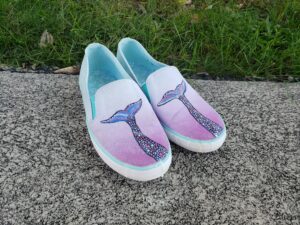 When she first started painting on shoes, a few of her followers had suggested that she try painting mermaids because mermaids are so popular, especially in some of the coastal Facebook groups. She enjoys further developing her art skills, so this design was created.
When she first started painting on shoes, a few of her followers had suggested that she try painting mermaids because mermaids are so popular, especially in some of the coastal Facebook groups. She enjoys further developing her art skills, so this design was created.
Let’s Talk Fast Fashion vs. Slow Fashion
At this point, Katrina and I thought it would be helpful to share some information about why upcycling projects like her shoe art are important, and also why it’s important to be a “smart shopper” whenever possible. So, let’s look at fast fashion vs. slow fashion.
 Fast fashion is a term that refers to the creation of seasonal fashions at an off-runway price for fashion-minded consumers.
Fast fashion is a term that refers to the creation of seasonal fashions at an off-runway price for fashion-minded consumers.
Fast Fashion produces several collections per year, with fast production times and affordable price tags. We will share some of the problems caused by fast fashion below, and why it’s better for our environment to instead strive for participation in slow fashion.
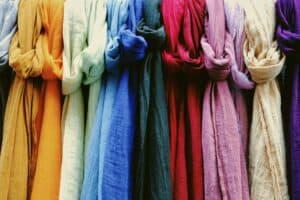 Slow fashion appeals to eco-conscious consumers and focuses on what materials are used in the clothing, how its production affected the environment, how it is made, what their working conditions are like.
Slow fashion appeals to eco-conscious consumers and focuses on what materials are used in the clothing, how its production affected the environment, how it is made, what their working conditions are like.
It also places emphasis on quality over quantity and the selection of timeless pieces that can be worn for long periods of time.
Fast Fashion and the Environment
Fast fashion is one of the major contributors to global warming and natural resource degradation. According to this NY Times article, more than 60% of fabric fibers used in fast fashion produced clothing are synthetically derived from fossil fuels.
Approximately 85% of textile waste in the United States is dumped in landfills, while the synthetic fibers in the clothing will not decompose. Many of those microfibers are microplastics that will end up in our oceans and freshwater lakes and rivers.
Fast fashion is also in direct relationship with global climate change through unsustainable production methods, environmental impacts, and exploitation of laborers among inhumane working conditions.
Environmental Impacts
According to the non-profit organization Sustain Your Style, the fashion industry is the second-largest generator of pollution in the world, behind the oil industry.
Water Pollution and Consumption
In many countries that produce clothing, untreated toxic wastewater that contains lead, arsenic, mercury, and more. Often, it is dumped directly into freshwater systems. Another water contamination source comes from the use of fertilizers on cotton crops, which pollutes water systems via runoff and evaporation.
On the consumption side, up to 200 tons of freshwater are used per ton of dyed fabric. Cotton farming also uses large amounts of water. Producing 1 kg of cotton uses up to 20,000 liters of water. This adds up to equal approximately 1.5 trillion liters of water used annually by the fashion industry.
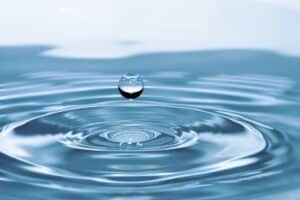 This extreme usage increases the scarcity of fresh water and contributes to the desertification of water sources. There are 750 million people in the world without access to drinking water. Of those, 100 million are in India. Coincidentally, about 85% of the daily water needs for the entire population of India would be met by the water that is used to grow cotton in their country.
This extreme usage increases the scarcity of fresh water and contributes to the desertification of water sources. There are 750 million people in the world without access to drinking water. Of those, 100 million are in India. Coincidentally, about 85% of the daily water needs for the entire population of India would be met by the water that is used to grow cotton in their country.
Microfibers and Microplastics
Every time we wash clothing containing synthetic materials, there are approximately 1,900 plastic microfibers released into the water. These eventually find their way to freshwater sources and our oceans. Next, they are consumed by small aquatic organisms and introduced into our food chains. An estimated 190,000 tons of microplastics end up in our oceans each year.
Waste Accumulation
In the western world, the average family gets rid of approximately 30kg of clothing per year, and only about 15% of that is recycled or donated. Three years is the average lifetime of a garment by an average consumer, and the synthetic fibers that are used in 72% of our clothing are non-biodegradable and can take up to 200 years before they decompose.
Excessive Use of Chemicals
Did you know that chemicals are one of the main ingredients in your clothing? Chemicals are used throughout the textile manufacturing process including farming, harvesting, dyeing, bleaching, and wet processing.
This extensive chemical use has resulted in diseases and premature death among cotton farmers. It has also contributed to water pollution and soil degradation, and is potentially harmful to consumers.
Greenhouse Gases
Consumers around the world purchase millions of garments each year. This contributes to the global fashion industry generating 10% of global carbon emissions through production, manufacturing, and transportation. The countries that produce the largest volume of clothing use coal as their primary energy source, which produces more carbon emissions than other energy sources.
 Synthetic fibers like polyester, acrylic, and nylon are made with the use of fossil fuel, which uses more energy than clothing made with more natural fibers. The annual production of polyester alone uses 70 million barrels of oil.
Synthetic fibers like polyester, acrylic, and nylon are made with the use of fossil fuel, which uses more energy than clothing made with more natural fibers. The annual production of polyester alone uses 70 million barrels of oil.
Soil Degradation and Deforestation
Global soil degradation is a large threat to our planet and affects global food security. It also contributes to global warming. The fashion industry contributes to the issue by overgrazing oats and sheep in pastures to produce cashmere and wool.
Other factors are excessive chemical use for cotton production and deforestation to create wood-based materials like rayon. Each year, 70 million trees are cut down to produce textiles. And sadly, approximately 30% of rayon and viscose clothing comes from endangered and ancient forests.
If collective global practices don’t change, continued soil degradation will likely lead to a food production decrease of 30% over the next 20-50 years.
Statistics in the above section were obtained from the previously linked article from SustainYourStyle.org.
So, What Can We Do to Help?
Katrina wants to reassure people who feel like you cannot make a difference. She says, “I feel this way often, especially after reading about our fast-fashion, consumerist, materialistic society. It can be depressing and discouraging to think about how consumerism has negative environmental effects and exploits 3rd world nations.”
Some Tips from Sustain Your Style
- Purchase clothes made in countries like Europe, Canada, and the United States. Their environmental regulations for textile factories are stricter and they have more renewable energy sources.
- Choose organic and natural fibers that do not use chemicals in their production. These materials also don’t release microplastics when laundered and can biodegrade when they end up in a landfill.
- Choose fibers like linen and recycled fibers that use low amounts of water in production.
- Buy fewer clothes and invest in higher quality garments. Also, mend clothing to extend its life cycle and recycle/donate clothing when you are ready to pass it on.
- Shop from companies that follow sustainable production and manufacturing practices.
 Katrina went on to say that she finds that being part of a sustainable community that places value on natural resources and ecosystems helps encourage her to channel her creative outlet into creating her upcycled shoe art.
Katrina went on to say that she finds that being part of a sustainable community that places value on natural resources and ecosystems helps encourage her to channel her creative outlet into creating her upcycled shoe art.
She also finds motivation as she participates in upcycling, sustainability, and eco-conscious groups on social media. “It is inspiring to see that so many people place value on old fabric materials. It’s great to see them use their creativity to give these items a new life and worth,” she said.
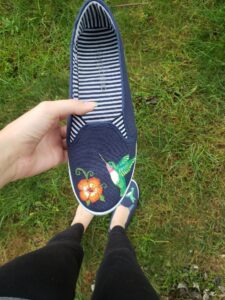 She hopes that more people start to recognize that our current consumer-based society is not a sustainable way of living. She encourages everyone to make a conscious effort to shop for clothing made from natural and organic fibers. It is also important to choose garments manufactured in countries with environmental regulations and renewable energy sources.
She hopes that more people start to recognize that our current consumer-based society is not a sustainable way of living. She encourages everyone to make a conscious effort to shop for clothing made from natural and organic fibers. It is also important to choose garments manufactured in countries with environmental regulations and renewable energy sources.
Katrina said, “It would be beneficial if more consumers would shop from upcycled artists rather than fast fashion industries. I give my money to small business owners when possible because I know they need it more than large corporations.”
Contact/Follow Katrina
I hope you enjoyed learning more about fast fashion, and about Katrina’s unique and upcycled shoe art. For more information, you can find Katrina’s Art Studio on Facebook or Instagram.
Note: This wasn’t a paid sponsorship. I just like supporting small businesses, and wanted to share the story of sustainability artist, Katrina’s Art Studio.
Other Spotlight Series Posts
Other Clean & Green Living Posts



Well done! We are reposting on behalf of Katrina to support her sustainable designs and your lovely blog! Thank you! We are going to showcase her shoes and the process @ThePodcastPad. Thank you 😊
Hi Cynthia, thank you so much! I’m glad you enjoyed the article. Thanks for the shoutout!